What Causes Bags Under Your Eyes?
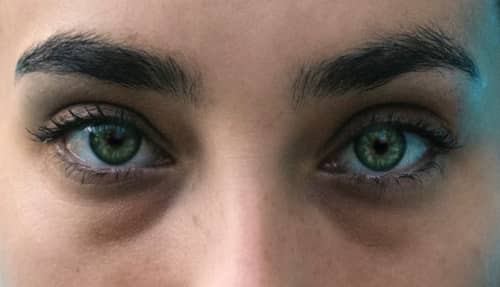
Puffy eye bags are a common concern that affects people of different ages, and can be due to very common causes. Eye bags can occur in young, energetic, and healthy people, but they are perceived by others as looking tired, weary, or in some presumptive cases being under the influence of drugs. I’ll discuss the different causes of puffy eye bags, as well as their treatments which include non-surgical, and surgical procedures for constantly visible eye bags.
The most common causes of bags under eyes are:
- Lack of sleep
- Excessive salt intake
- Allergies
- Sinus issues
- Lower eyelid fat prolapse
Lack of Sleep
The most commonly known reason for eye bags is a lack of sleep. With sleep deprivation, there is a loss of tone of the muscle supporting the lower eyelid, so it can appear puffy temporarily. The lack of sleep also causes the blood vessels to dilate, which increases blood flow. Since upper and lower eyelid skin is the thinnest in the body at only 0.5mm thick, the blood vessels can be visible through the thin skin. While these are commonly and more accurately called dark circles, they are also referred to as eye bags. These causes of puffiness and darkness are temporary, and only last until one can get proper rest, so they don’t need medical treatment.
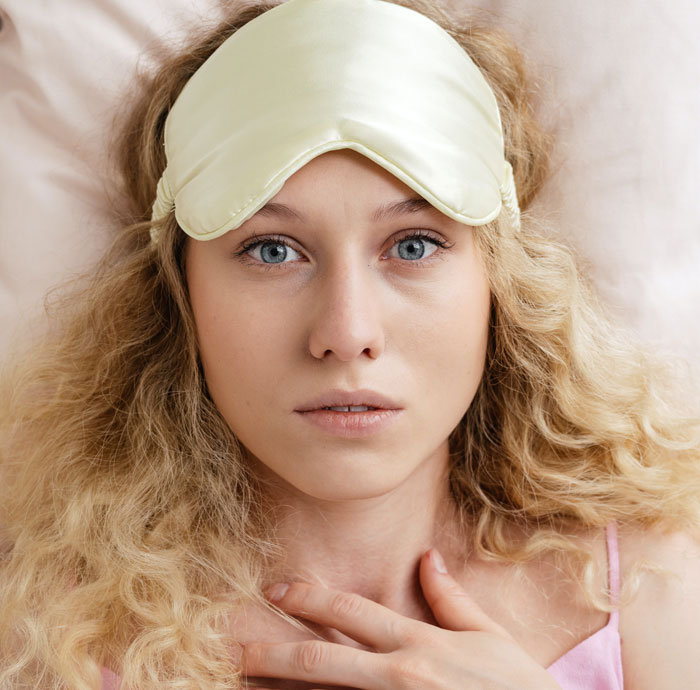

Excessive Salt Intake
Eye bags can appear temporarily due to excessive salt intake. This type of eye bags can appear the day after a particularly salty meal. Excess salt can cause the body to retain water. Since the skin of the lower eyelids is the thinnest in the body at about 0.5mm thick, this water retention can be seen more clearly through thin eyelid skin. Eye bags due to salt intake may require a doctor to diagnose, but it doesn’t require medical treatment. The solution for this cause of bags under your eyes is to reduce salt in the diet.
Allergies
Allergies can also cause temporary eye bags. An allergic reaction to external factors like food, pollen, or dust causes the body to produce histamine, a chemical that causes swelling and inflammation. Eye bags due to allergies do require medical intervention to determine what someone may be allergic to, and for the proper antihistamine to reduce inflammation and puffiness. Some of the indicators that eye bags are caused by allergies are that they are not puffy all the time, but rather come and go depending on exposure to allergens.
Lower Eyelid Fat Prolapse
A common cause of eye bags which I treat in my patients every day is called lower eyelid fat prolapse, or herniated orbital fat. Orbital fat normally surrounds and cushions the eyeball. Orbital fat at the lower part of the eyeball can sometimes herniate or prolapse forward, thereby causing bulges under the eyes. When puffy eye bags are caused by prolapsed or herniated fat, they are always visible, no matter how much sleep you get, or how otherwise healthy you are.
The most common reason to have them treated is people saying, “I’m tired of looking tired”. Eye bags can make someone look weary all the time, even if they are not as the puffiness does not go away because the fat remains in place. Prolapsed orbital fat does not go away, or retract back on its own. Prolapsed orbital fat does not reduce in volume with diet and exercise because it’s meant for eyeball protection and cushioning, not calorie storage like most fat in the body.
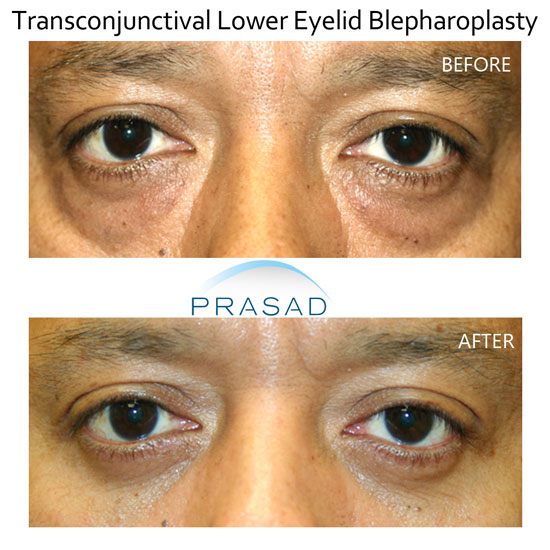
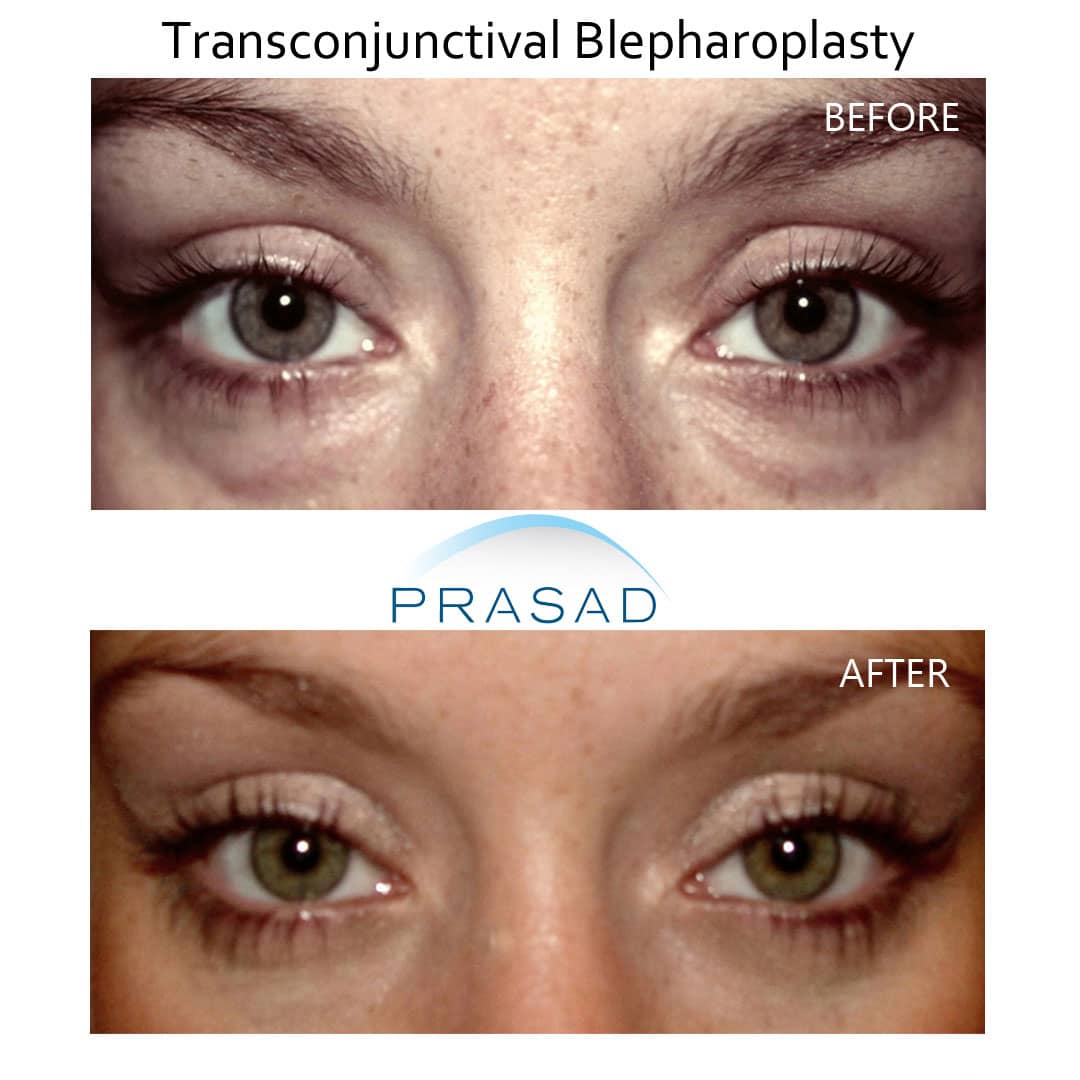
Lower eyelid prolapse can be hereditary, so it can occur in younger people. Puffy eye bags can also be due to aging as the tissue in the lower eyelid becomes weaker with time, so orbital fat can herniate past the weakened tissue. Toxic lifestyle factors like smoking can also accelerate aging by weakening the eyelid skin and underlying tissue. Eye bags caused by prolapsed orbital fat is what I treat in my patients every day in my practice.
How to Remove Under Eye Bags: Surgical Option
Transconjunctival Blepharoplasty
My approach to eye bags due to prolapsed orbital fat is more specialized than the more common procedure performed by most general plastic, or general cosmetic surgeons. To get rid of the puffiness, I operate by sculpting and removing the prolapsed fat that causes these bulges from behind the lower eyelid, without making an incision on the eyelid skin. A small incision is made in the membrane called the conjunctiva to access the fat pockets to sculpt, and excise the fat causing the puffiness.
This is a more difficult technique for the surgeon as the incision is much smaller than the one that would be made in the more commonly practiced transcutaneous blepharoplasty, which makes the incision on the lower eyelid skin. This approach is called transconjunctival blepharoplasty, which looks more natural because there is no chance of a visible scar, like you never had eye bags. Even a doctor taking an up close eye exam will not be able to tell you had surgery.
This is in contrast to the approach taken by most general plastic or cosmetic surgeons where an incision is made in the lower eyelid, usually below the eyelashes, so the fat can be sculpted and removed through the incision. While transcutaneous blepharoplasty can be performed well, and the incision virtually unseen, surgeons who train with this technique, but don’t perform it too often may leave visible incision lines. The transcutaneous method of lower blepharoplasty is also more prone to complications as the external incision can compromise delicate eyelid support structures, while the transconjunctival method leaves support structures completely intact.
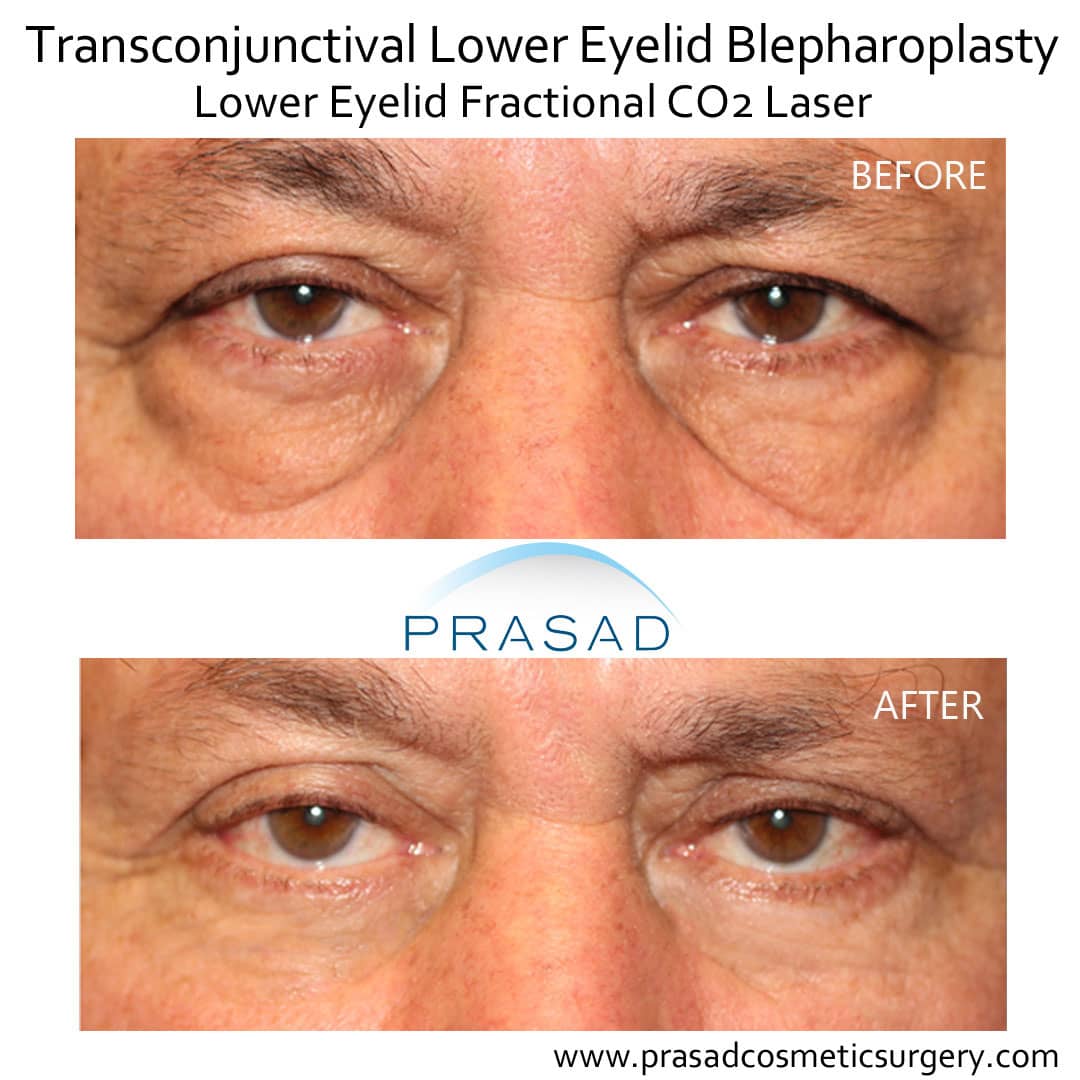
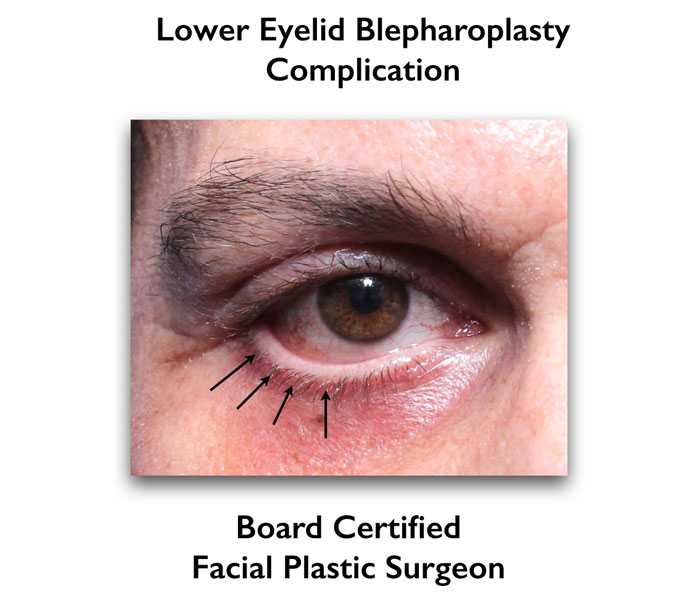
Increased Risks with the Transcutaneous Blepharoplasty Approach
Surgeons using the transcutaneous blepharoplasty method also often excise lower eyelid skin in an attempt to improve wrinkles. The problem with excising skin is that wrinkles are due to diminishing skin quality, not excess skin quantity, so removing eyelid skin often results in a skin shortage. An eyelid skin shortage leads to problems like lower eyelid retraction, where the eyes look rounded and can become irritated; or ectropion, where the lower eyelids revert outward; or entropion, where the lower eyelids curl inward. To avoid these complications, I don’t perform any skin removal to treat wrinkles, but rather treat wrinkles in the lower eyelids to improve skin quality.
Non-surgical treatments like platelet-rich plasma, or PRP, can improve the skin quality of the lower eyelids by stimulating collagen and blood supply and thickening the skin. Thermal treatments like lasers or radiofrequency can tighten the skin, and resurface it by taking off the top skin layer so fresh skin grows in, while stimulating the body to produce collagen for smoother, stronger skin to improve the appearance of wrinkles.
Bags Under Eyes Surgery Recovery
There may be some temporary bruising after surgery, but this usually resolves quickly. Patients return to work in about a week and sometimes need some concealer for the bruising, but often bruising resolves before they return to work. Removing eye bags with lower eyelid surgery can brighten up the whole face, and takes years off facial appearance, similar to a more extensive procedure like a full surgical facelift.
How to Get Rid of Under Eye Bags without Surgery
Fillers for Mild Eye Bags
For some less pronounced cases of eye bags, a cosmetic filler can also be used for treatment. If eye bags don’t exceed a certain threshold, a filler can blend the transition between the puffiness and the lower eye. Hyaluronic acid fillers do require periodic maintenance as the material is gradually metabolized, so fillers do need to be reapplied usually every year, but sometimes less, depending on the metabolism of the patient.
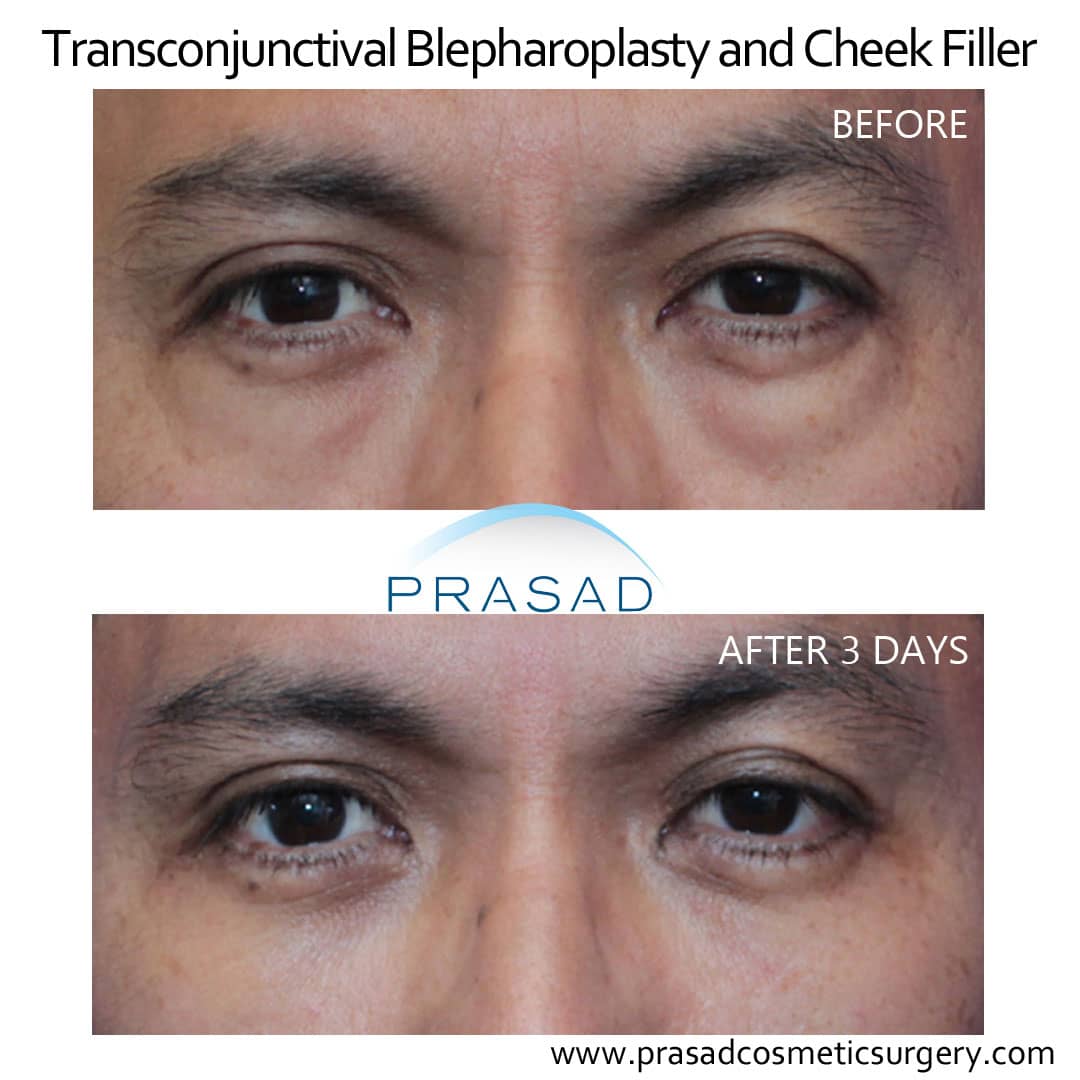
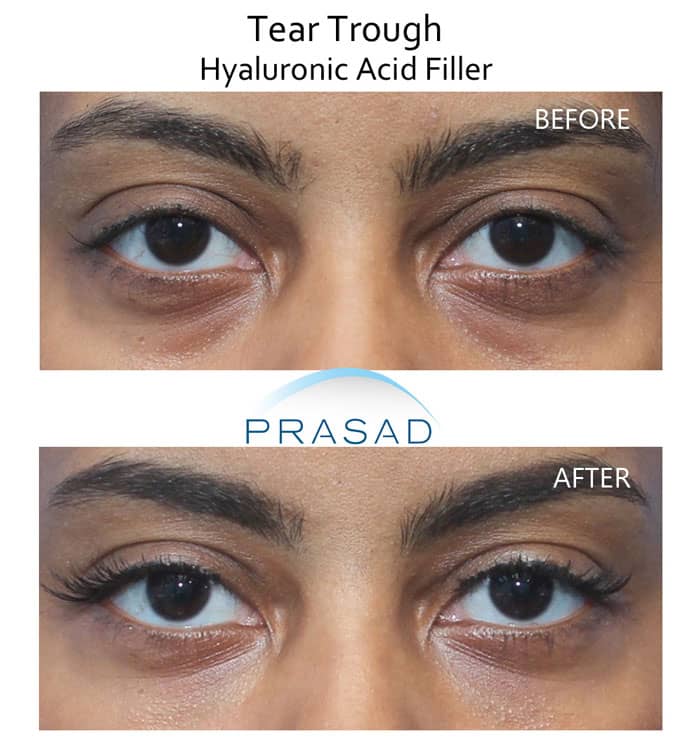
Also, many doctors who aren’t surgeons or non-physician practitioners may use fillers in all cases of eye bags they come across, even if filler is not the right treatment. Sometimes, this approach to avoiding surgery, usually because they aren’t trained or licensed for surgery, can result in the filler causing bigger eye bags.
As long as a hyaluronic acid filler was used for treating eye bags and made the bags worse, it can be dissolved with injectable enzyme hyaluronidase. Often, people who tried filler for their eye bags but it didn’t work out well for them eventually get lower eyelid surgery for longer-lasting results, as well as a more definitive outcome since the fat causing the puffiness is removed rather than camouflaged or blended temporarily with filler.
Many people have filler treatment, thinking that it’s more convenient and faster to recover from than lower eyelid surgery. However, filler treatment under the eyes usually involves some bruising due to the trauma of the needle, so patients often still recover from a non-surgical filler treatment for about a week until the bruising resolves.
The way I perform lower eyelid surgery without any skin removal, external incision, and local anesthesia with LITE IV sedation, the possible bruising from the surgery also lasts about a week, so recovery is comparable.
Patients return to work in about a week after surgery. Unlike filler treatment that may cause temporary bruising after maintenance treatments, lower eyelid surgery lasts much longer, so there isn’t a need to regularly recover from treatment in the foreseeable future.
How Long Does Lower Eyelid Surgery Last?
The results of lower eyelid surgery can last many years, even decades. I had a patient who had an operation when I was still starting my career almost 30 years ago, and she said her eye bags never came back. For many patients, the results of one eye bag surgery can last a lifetime, but for others it usually lasts many years. The prolapsed fat that causes eye bags doesn’t come back once it’s removed, but this doesn’t mean that new orbital fat can’t prolapse again. Older people are at a higher risk of having eye bags again because the tissue in the lower eyelid can weaken with age, so orbital fat can herniate through this weakened tissue. Regardless of what age surgery is performed, lower eyelid surgery does have definitive, long-term results as long as it’s performed without any skin removal.
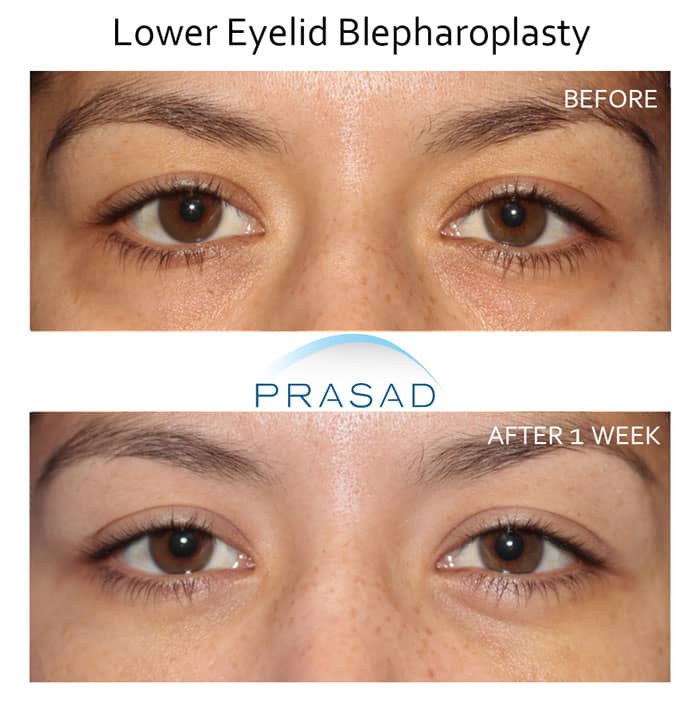
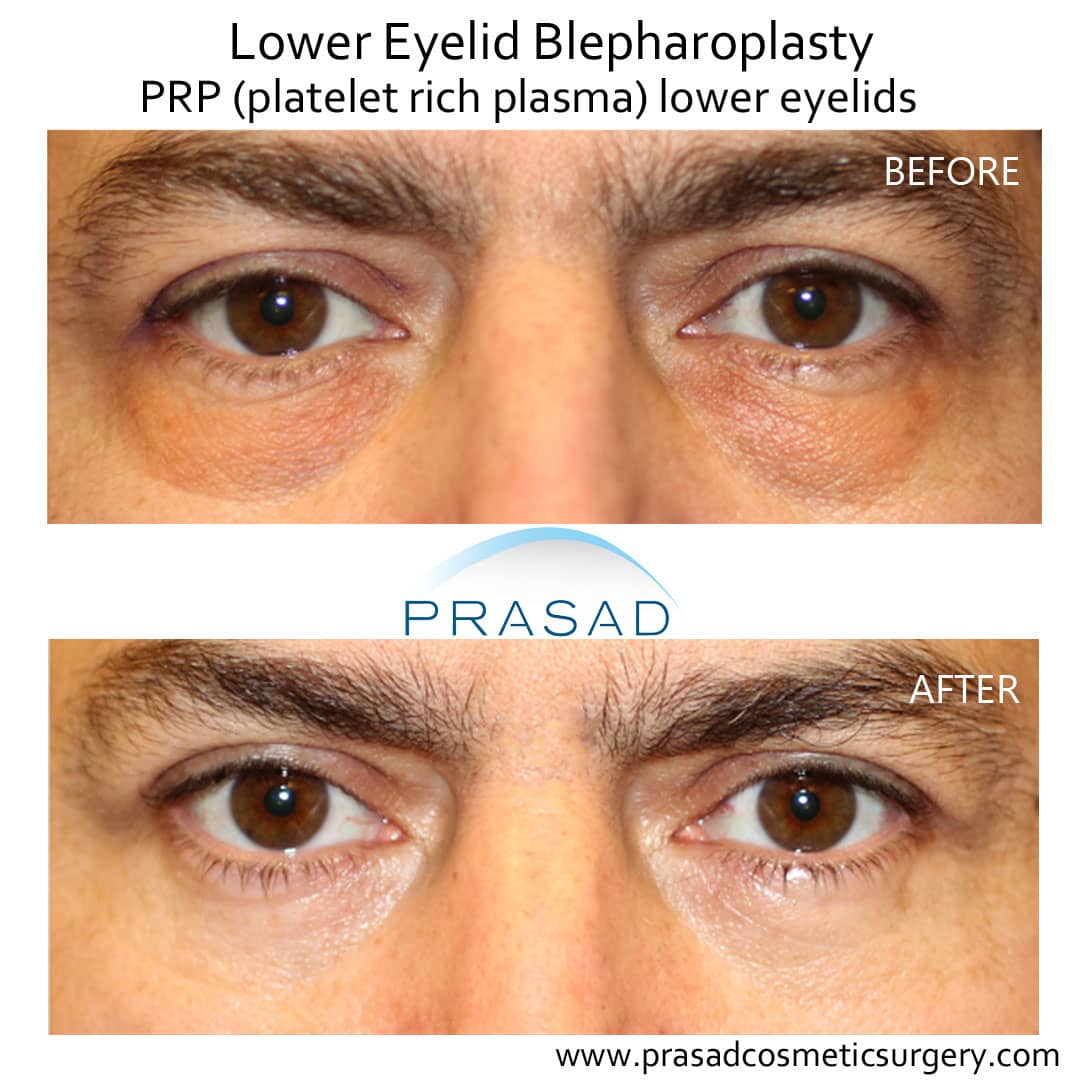
Under Eye Bags: When to Seek Medical Help
If you have eye bags, the most important thing to do first is have their cause diagnosed. Medical intervention is not needed for temporary eye bags due to excessive salt intake, or a lack of sleep as these resolve on their own.
Eye bags due to allergies often have other symptoms such as itchiness and redness, so to relieve the appearance and its symptoms, a doctor such as an allergist can help. If eye bags are present all the time, no matter how much sleep you get, and they don’t appear red or feel itchy, it is most likely due to prolapsed orbital fat.
Just remember that not all lower eyelid surgery is performed the same way, so seek an eyelid specialist. If they recommend surgery, ask for transconjunctival blepharoplasty by name for a more natural-looking result and a specialized surgical approach that is less prone to complications. I hope you found this information helpful.
Blepharoplasty Surgery Manhattan NYC and Long Island, New York
Dr. Amiya Prasad is a Board-certified cosmetic surgeon, and Fellowship-trained oculoplastic surgeon. He’s been practicing in New York City and Long Island for over 25 years. Dr. Amiya Prasad is an eyelid specialist who performs upper and lower eyelid surgeries every day in his practice, as well as ptosis surgery and revision eyelid surgery to repair previous work done by other specialists. He also frequently performs non-surgical eyelid procedures like laser resurfacing, fillers, and platelet-rich plasma or PRP.
If you’re interested in recommendations for your individual situation, you may call any of our offices at (212) 265-8877 in Manhattan, New York City; (516) 742-4636 in Garden City, Long Island; or (703) 356-1336 in Vienna, Virginia, or fill up the form below to schedule an appointment.

